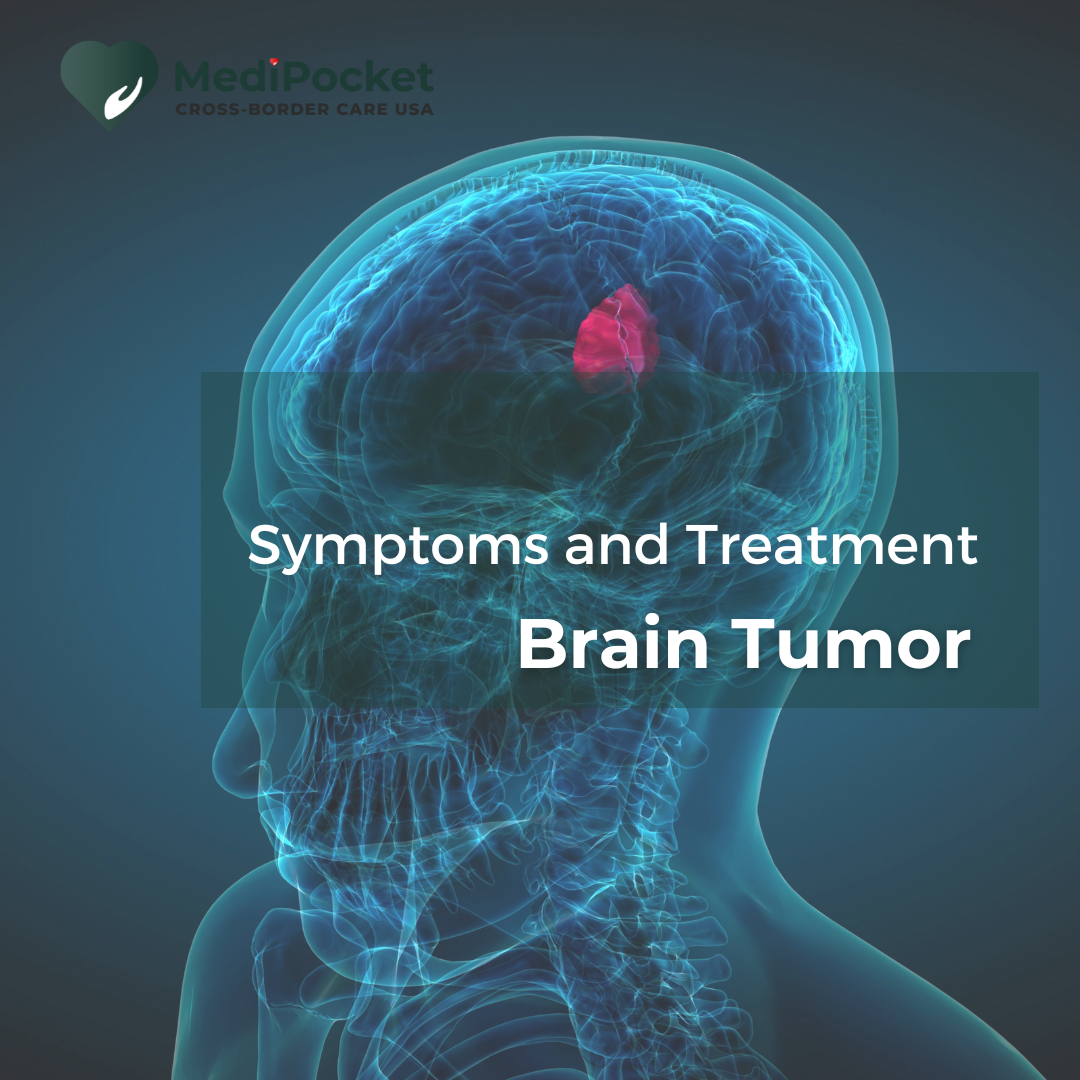An aberrant cell growth inside the brain or central spinal canal is called a brain tumor. The brain tissue itself, the meninges (the membranes that surround the brain and spinal cord), nerves, glands, or other regions of the body can all become the source of a tumor.

Brain tumors are broadly categorized into two types: primary and secondary.
Primary Brain Tumors: These have a brain source. They may be malignant, or cancerous, or benign, or neither. Malignant tumors are more aggressive, can migrate to other areas of the brain or spinal cord, and infiltrate nearby tissues. Benign tumors develop more slowly and typically have defined limits.
Secondary brain tumors: Secondary Brain Tumor, also known as metastatic brain tumors, start outside the body and move to the brain. These tumors are always malignant and are more common than primary brain tumors.
Types of Primary Brain Tumors:
In addition to discussing secondary brain tumors, we will examine the several kinds of primary brain tumors that arise from the brain or its immediate surroundings.
Primary Brain Tumors
1.Gliomas:
- Astrocytomas: Astrocytomas are a kind of glial cell that forms from astrocytes, which are responsible for supporting and shielding nerve cells. Glioblastoma is the most aggressive type, and they range in grade from low-grade (slow-growing) to high-grade (fast-growing and more aggressive).
- Oligodendrogliomas: These tumors are usually slowly growing but have the potential to become aggressive. They originate from oligodendrocytes, which form the myelin sheath that protects nerve fibers.
- Ependymomas: Ependymal cells that border the spinal cord’s central canal and the brain’s ventricles give rise to ependymomas. Their growth rate and level of aggression can differ.
2. Meningiomas:
- The meninges, the membranes that coat the brain and spinal cord and provide protection, are the source of these malignancies. The majority of meningiomas are benign and grow slowly, but because of their location and size, they can still create serious issues.
3. Pituitary Adenomas:
These benign tumors form in the pituitary gland, which controls the body’s hormone levels. Depending on their type, they can be either non-functional (not generating hormones) or functioning (producing surplus hormones).
4. Schwannomas:
Schwann cells, which create the myelin sheath that surrounds peripheral nerves, are the source of these malignancies. One such is the vestibular schwannoma, or acoustic neuroma, which affects the nerves involved in hearing and balance.
5. Primary Lymphomas of the Central Nervous System (CNS):
These aggressive tumors are linked to immunodeficiency diseases like AIDS and are thought to be caused by lymphocytes, a type of white blood cell. They may manifest in the eye, brain, or spinal cord.
Secondary Brain Tumors (Metastatic)
Cancers that have metastasized from other regions of the body to the brain are known as secondary brain tumors. They are more frequent than primary brain tumors and are usually malignant. The following are typical primary sites for malignancies that spread to the brain:
- Breast Cancer
- Melanoma (skin cancer)
- Lung Cancer
- Kidney Cancer
- Colon
Rare and Other Brain Tumor Types
Craniopharyngiomas
These benign tumors are located close to the pituitary gland and, because of their proximity to the optic nerves, may have an impact on hormone levels and eyesight.
Pineal Region Tumors:
The pineal gland, which is deep within the brain and is in charge of producing melatonin and controlling sleep-wake cycles, is where these tumors grow. Benign pineocytomas and malignant pineoblastomas are two examples.
Tumors of the Choroid Plexus:
The brain region that creates cerebrospinal fluid, the choroid plexus, is the source of these uncommon malignancies. They may be cancerous (choroid plexus carcinomas) or benign (papillomas of the choroid plexus).
Embryonal Tumors:
These high-grade, very malignant tumors, like atypical teratoid/rhabdoid tumors (AT/RT), usually affect young children.
Depending on the size, location, growth rate, and kind of tumor, brain tumors can induce a wide range of symptoms. These symptoms arise from the tumor’s ability to pressurize surrounding tissues and impair brain function normally. The following is a thorough summary of the signs and symptoms of brain tumors:
General Symptoms:
Headache
- Intense or persistent headaches that are usually worse in the morning or while you’re lying
- down.
- headaches that get worse with time.
- headaches along with vertigo or nausea.
Seizures:
- seizures that start suddenly in a person who has never had epilepsy before.
- several kinds of seizures, including absence, focal, and convulsions.
vomiting and nauseous:
- Often occurs in the morning and may be associated with headaches.
- Can be persistent and unrelated to eating.
Changes in cognition or mental state:
- issues with concentration or memory.
- alterations in behavior or personality.
- confusion or loss of direction.
Fatigue:
- widespread weakness or a weariness that doesn’t go away after you rest.
Specific Symptoms Based on Tumor Location
Frontal Lobe:
- alterations in behavior or personality.
- impaired ability to make decisions or solve problems.
- weakness or trouble moving on one side of the body.
Parietal Lobe:
- difficulty orienting oneself spatially or using touch sensation.
- difficulties with language comprehension, writing, or reading.
Temporal Lobe:
- Issues with memory or trouble creating new memories.
- Hearing issues or delusions related to hearing.
- Difficulties comprehending spoken words.
The occipital lobe
- Abnormalities in the eyesight, such as deficiencies in the visual field or loss of vision in one eye.
- Inability to recognize faces or objects.
Cerebellar:
- Loss of coordination or balance.
- Fine motor skills difficulties, such as trouble writing or buttoning garments.
- Wooziness or dizziness.
Brainstem:
- Difficulties balancing or walking.
- Difficulty speaking or swallowing.
- Variations in breathing or heart rate.
Additional Signs
Issues with Vision:
- Double or fuzzy vision.
- Peripheral vision loss.
- Anomalies in eye movement.
Issues with Hearing:
- Ear ringing or loss of hearing (tinnitus).
Speech and Linguistic Challenges:
- Difficulty speaking or uttering the appropriate words.
- Slurred words.
Dysfunction of the motor system:
- A bodily portion that is paralyzed or weak.
- Inability to coordinate or carry out daily chores.
Modifications to the senses:
- Tingling or numbness in the face or limbs.
- Altered taste or smell perception.
Endocrine Dysfunction (if the tumor affects the pituitary gland):
- hormonal abnormalities causing alterations in development, libido, or menstruation.
- signs of either an excess or a shortage of hormones, including changes in mood, weariness, and weight gain or loss.
Factors Affecting the Symptoms
- Tumor Growth Rate: Symptoms typically appear more quickly and severely when a tumor grows more quickly.
- Tumor Size: Because larger tumors put more pressure on the brain’s tissues, they are more prone to manifest symptoms.
- Tumor Location: The specific symptoms are associated with the brain region where the tumor is located.
When to Get Medical Help?
- Headaches that never go away or get worse.
- Unexpected or novel seizures.
- Progressive neurological impairments, including speech difficulty, vision issues, or weakness.
- Abrupt alterations in cognition, conduct, or personality.
Treatment of brain tumors and the improvement of outcomes depend heavily on early diagnosis and treatment. It’s crucial to get medical advice from a specialist if you or someone you know has these symptoms so they can be further evaluated.
MediPocket helps the patients from around the world access the best possible treatment plan for Brain Tumor. With advanced care and facilities in the hospitals in the USA, we bring you the top-notch expertise to you without any hustle.





